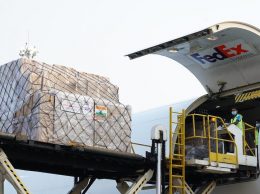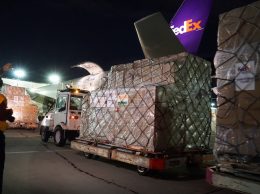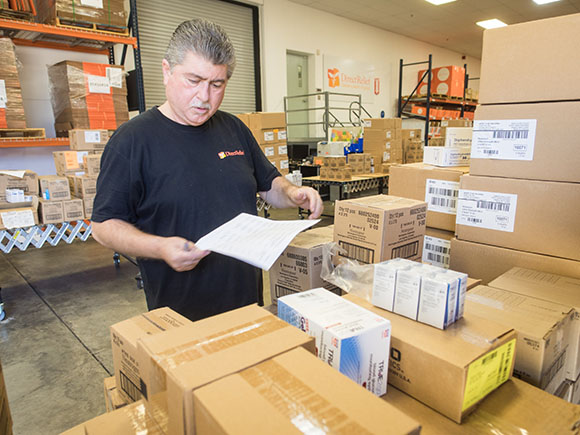
Direct Relief International warehouse operator Henry Rodriquez gathers medical supplies to be shipped to various clients. (Nik Blaskovich / Business Times photo)
As Goleta-based nonprofit Direct Relief International makes strides to provide more medicines and disaster relief supplies both domestically and abroad, the organization is leveraging the strengths of its corporate partners to accommodate scale and maximize efficiency.
In 2013, Direct Relief provided $346 million in humanitarian aid to 69 counties including the United States. That work accounted for 5,552 shipments of pharmaceuticals, medical supplies and medical equipment — a more than 500 shipment increase over 2012’s total.
With a new distribution and office facility in the planning stages, the charity expects the ability to ramp up capacity by almost four times the current level.
Direct Relief recently ranked No. 45 on the Chronicle of Philanthropy’s 400 largest charities list, jumping 10 spots from the previous year.
Working directly with product manufacturers and the philanthropic programs of companies such as FedEx, GlaxoSmithKlein, GIS software provider Esri and more than 150 other companies, Direct Relief has built a scalable response, sourcing and distribution network that’s more efficient and targeted than simply sending bulk aid.
Building a commercial-grade network has been an “intense” seven-year effort that started with the implementation of SAP software to better manage inventory and operations. The organization’s “information backbone” as president and CEO Thomas Tighe called it, has been key in Direct Relief’s efforts despite the physical constraints at the current distribution center, and on the ground in countries with limited or no supply chain infrastructure.
“[The system] is really important for us because we’ve seen it so often that you can’t just send stuff because it will create an immediate bottleneck … and then nothing gets through,” Tighe said. “In the impoverished places we work, with little commercial incentive, one of the big consequences becomes the lack of a coherent and efficient supply chain for medications … I think the reason we we’re able to dial it up is because we did have a system that anticipated scale. All commercial systems do and that’s been a great benefit for us.”
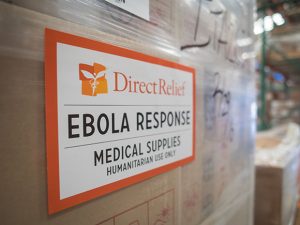
A box of Ebola response supplies ready for shipment at Direct Relief’s Goleta headquarters. (Nik Blaskovich / Business Times photo)
In countries like Sierra Leone, Liberia and Guinea, where the struggle against the outbreak of Ebola is most severe, Direct Relief has coordinated with its in country partners to deliver 140 tons of medical resources is smaller, easier to manage lots. With its logistics capabilities, Direct Relief continues to work with local medical staff and ministries of health to support the broader health systems by strengthening the inbound supply chain and in-country distribution of medical resources.
The organization has sent 19 emergency shipments supporting more than 600 facilities to date. Additional shipments of essential supplies — primarily protective gear, typical medicines and equipment — are currently being collected for transport in the coming weeks.
“Before Ebola [these countries] were having a hard time just meeting the health care needs of all the people. Beyond the medicines and things needed to fight Ebola, the things they need include stuff just to be able to run their basic health infrastructure and meet the requirements of their health systems,” Tighe said.
He likened the situation with the countries’ medical resources to California having to fight a wildfire in the drought.
“All their resources are being used to put out the fire,” he said. “They’ve thrown everything they have at fighting Ebola and that’s left them short of everything else … A big push has just been trying to flow in personal protective gear.”
The latest round of supplies is being paid for through Direct Relief’s internal funds.
“With our Ebola response, we are actually investing the money ourselves ahead of raising funds because in terms of timing we have to respond right away and once we do that we can try to backfill those expenditures,” said Bhupi Singh, executive vice president and chief financial officer for Direct Relief. “In the last eight to 10 years we have never had challenges to responding financially and built in surge capacity in our budget and with our physical facility, although that’s becoming increasingly difficult.”
Direct Relief’s average annual operating cost is typically between $10 million and $12 million in a non-emergency year; however last year, with a massive relief effort still going out to Hurricane Sandy victims and other emergency situations, the budget swelled to $19 million — the largest in the organization’s history.
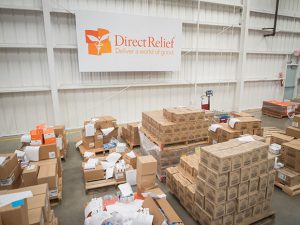
A new warehouse facility in development would alleviate constraints at the nonprofit’s current location. (Nik Blaskovich / Business Times photo)
Going forward, while individual monetary donations will continue to play an important role in punching up Direct Relief’s aid efforts, collaborations with corporate partners, especially in the technology and manufacturing space, is the center of the nonprofit’s business strategy.
“It’s almost a paradox of our times where we see the efficiency that business drives and things get better, faster, cheaper through the fierce competition that exists in the marketplace, but when there isn’t a business case to something, like providing aid, none of that kicks in,” Tighe said.
“Companies are naturally going to focus on things intended to be profitable, so things that aren’t necessarily profitable, but are important public benefits, that’s what we’re trying to meld. How can we perform the functions to advance a social good with the most efficient actors in the world?”
As a pet owner, Tighe said he has three different dog whistling apps on his phone and he’s sure there is someone probably working on a better one, but that he’s less certain there is someone out there developing the “better inventory management system for humanitarian crisis app.” Still, adapting tools for market research and engineering go beyond the products and the technology, Singh said.
“The human resources these companies can provide can often be as big of a help to us,” he said. “With [GlaxoSmithKlein], we’ve been able to have four volunteers spending six months with us, providing us the talent we would have never been able to afford, hire or even attract.”
Through the program, Direct Relief gets access to senior level people who have specialties in various areas including consulting, strategy, communications and marketing and operations.
“We’ve been really fortunate in the last decade with the tech community in particular,” Tighe said, “but what we’re always saying is, ‘we’d love to have your money, but what we really want is what made you your money.’ ”






 Print
Print Email
Email